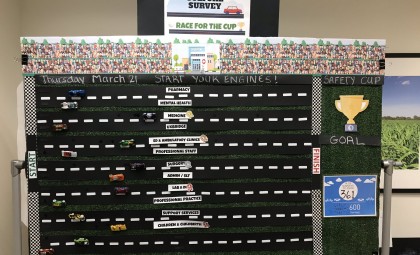Start Your Engines!

Every day for nearly a month, patients, staff, physicians and volunteers at Markham Stouffville Hospital (MSH) walked by a model racetrack with the words “START YOUR ENGINES!" written across the top – an unusual sight for those who weren't in the know.
Attached to a large rolling whiteboard, the racetrack was surrounded by fake plastic grass, an excited two-dimensional crowd, and a checkered finish line. It also featured 12 separate lanes with toy cars belonging to each of the hospital’s departments fiercely competing for the coveted Safety Cup.
What’s the Safety Cup?
The Safety Cup is the brainchild of MSH’s Quality and Safety (Q&S) team, spearheaded by Karen Chapman, Manager of Patient Safety. The model racetrack was built to both inspire and showcase the units that had completed the most Safety Culture Surveys to reach the hospital’s ultimate goal of 600 responses. It was a fun and effective way to not only spread awareness, but also to improve current processes and strengthen the safety culture within the hospital’s community.
The Safety Culture Survey is a standard, confidential questionnaire created for our healthcare system by Accreditation Canada. “Senior management has a clear picture of the risk associated with patient care” and “My organization effectively balances the need for patient safety and the need for productivity” are two examples of queries found on the survey. The results are meant to help inform strategies regarding safety culture and general work-life at the hospital.
Though safety culture improvement at MSH was the survey’s primary purpose, the project itself went beyond that for the Q&S team. It was also about engaging frontline staff while showing them that they are valued, appreciated, and heard.
"Our Quality and Safety team knows that anytime we can make it fun, it will make engaging our team easier,” says Barb Steed, Executive VP of Patient Services and Chief Practice Officer. “Luckily, we have lots of healthy competition here, and when people heard of the racing concept and a chance to win a trophy, we knew there would be plenty of interest.”
From March 18 onwards, staff were updated about who was in the lead at the start of each day to motivate them. There were many different ways to access the survey, with it being available online, accessible via QR code, and physically with paper copies.
Members of the hospital’s Patient Experience Participants (PEP) program assisted in the project, using tablets to bring information and details to staff and patients. PEPs are patients or their family member(s) who – in a volunteer capacity – work with hospital staff and physicians, sharing their ideas, perspectives, and experiences to help improve the overall patient experience.
In the winners’ circle
MSH’s surgery team was the big winners of the inaugural Safety Cup competition. They’ll have their department team name engraved on one of the Safety Cup’s nine plaques which line its bottom. After announcing the winner on April 8, the trophy was filled with a bounty of delicious chocolate and shared with everyone in the surgical unit.
“One of the organization’s main goals with this initiative was to increase the response rate from the previous survey in 2017," says Chapman. "The target was 600 survey responses – we got 903."
That wasn't the only evidence of the project's massive success. Another one of the goals was to increase the physician participation response rate, and they did so by almost 400 per cent.
“Seeing our directors and managers rallying their teams together, including physicians, was really special,” says Chapman. “They went out there, promoted the project and encouraged their staff to participate enthusiastically.”
The excitement of the challenge and daily promotion stoked the competitive spirit of MSH staff, leading to many day-to-day discussions on safety and what could be done to better it.
Learning to improve the safety culture
After all survey responses are collected, they are thoroughly analyzed to find areas and opportunities to improve safety culture.
“As someone with a background in risk, I certainly have an awareness of how important a good safety culture is, so we work closely with our Risk team and HIROC’s Risk Assessment Checklists post-survey,” says Chapman. “We review the responses and learn where we need to focus. For example, if we find a particular issue, we take a look to see if it’s a risk organizationally.”
An example of an issue identified in past Safety Culture Surveys was MSH’s improving the reporting process of safety concerns in a just culture environment. That has been actioned by the Q&S team’s next project called Speak up for Safety. This campaign will focus on the importance of hospital staff, patients and physicians speaking up and bringing forward safety concerns more proactively, while creating a safe environment for reporting.
“With this new project, we want staff to know they’re concerns are being heard. So when a survey question asks ‘does someone follow-up?’ we want to hear ‘yes they do,’” says Chapman.
“We want to make it easier for people to participate. We're dedicated to promoting, improving and demonstrating we learn from what people tell us,” says Steed. “Engagement is critical. If you're not engaged in the problem, then you're not engaged in the solution either.”
Marc Aiello, Communications and Marketing Coordinator, HIROC